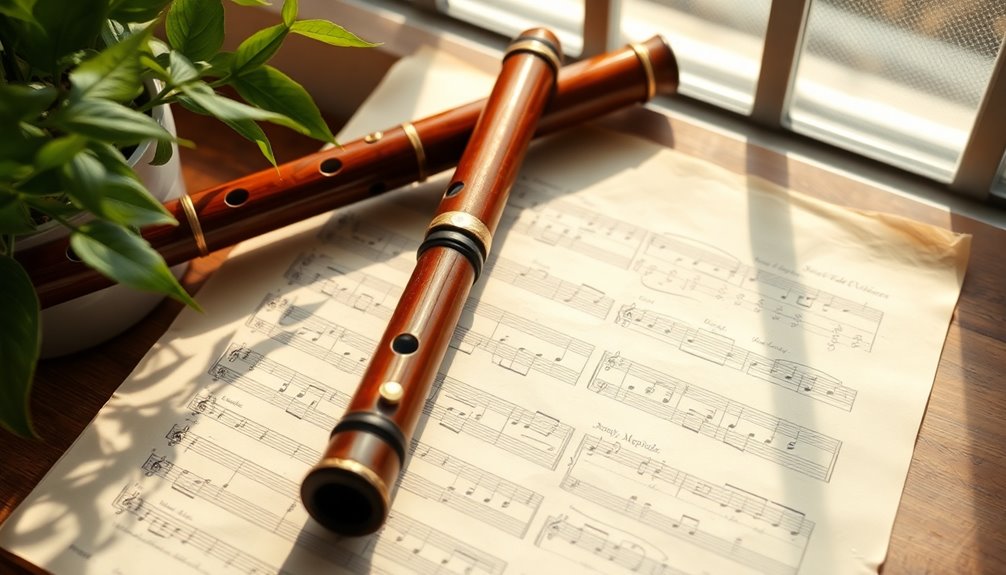If you're starting out on the flute, you'll love the selection of 80% easy songs designed for beginners. Begin with popular melodies, such as "Twinkle, Twinkle, Little Star," to build your confidence. Classic tunes like Bach's "Minuet in G" and folk songs like "Scarborough Fair" are perfect for enhancing your finger placement and breath control. Don't forget movie themes like "Hedwig's Theme" to keep your practice exciting! Seasonal favorites, alongside effective practice tips and essential techniques, will further enrich your learning journey. Stick around, and you'll uncover even more strategies to elevate your flute skills!
Key Takeaways
- Familiar Melodies: Start with popular tunes like "Twinkle, Twinkle, Little Star" to build confidence and practice finger placements effectively.
- Classic Pieces: Incorporate accessible classics like "Ode to Joy" and "Minuet in G" to enhance musical skills and phrasing.
- Folk Songs: Explore simple folk songs such as "Scarborough Fair" to reinforce technique and appreciate cultural significance through engaging rhythms.
- Movie Themes: Engage with beginner-friendly movie themes like "Hedwig's Theme" and "My Heart Will Go On" for emotional depth and expressive playing.
- Jazz Standards: Experiment with easy jazz standards like "C Jam Blues" to practice improvisation while enjoying distinctive melodies and structures.
Popular Melodies to Start

When you pick up your flute for the first time, it's exciting to plunge into melodies you already know. Familiar tunes not only boost your confidence but also help you connect with other musicians. Starting with popular melodies makes learning enjoyable and engaging, and it sets a solid foundation for your flute journey.
Beginner scales are essential for building your technique, but combining them with melody exercises can elevate your practice sessions. As you explore melodies like "Twinkle, Twinkle, Little Star" or "Mary Had a Little Lamb," you'll notice how the notes connect, making it easier to grasp finger placements and breath control. These simple tunes allow you to focus on creating beautiful sounds while developing your skills.
Incorporating melody exercises into your routine can also enhance your ability to play by ear. Try playing along with recordings or singing the melody first before attempting it on your flute. This approach not only strengthens your musical ear but also fosters a sense of belonging within the music community.
As you progress, you can challenge yourself with slightly more complex melodies, keeping your practice fresh and exciting. Remember, every flutist started where you're now. Furthermore, exploring beginner-friendly Disney flute songs can provide you with a delightful and engaging repertoire.
Embrace the journey, celebrate your achievements, and share your love for music with others. Before you know it, you'll be confidently playing melodies that resonate with you and your fellow musicians, creating a beautiful harmony together.
Classic Tunes for Flute

Classic tunes have a timeless quality that can elevate your flute playing to new heights. Embracing these classic compositions not only enhances your skills but also connects you to the rich tapestry of music history.
Each piece you learn has its own historical significance, providing you with a deeper understanding of the art form.
Here are some classic tunes that every beginner flutist should consider:
- "Minuet in G" by Bach: This charming piece showcases beautiful melodies and rhythmic patterns, perfect for developing your phrasing.
- "Ode to Joy" by Beethoven: Instantly recognizable, this uplifting tune will inspire joy in both you and your audience.
- "Air on the G String" by Bach: With its flowing lines, this composition helps you practice smooth shifts between notes.
- "The Entertainer" by Scott Joplin: This ragtime classic introduces syncopation, giving you a fun challenge while improving your timing.
Additionally, playing these classic pieces can enhance your understanding of finger placement techniques essential for developing proper flute skills.
Folk Songs for Beginners

Folk songs offer a rich and diverse repertoire that's perfect for beginner flutists. These traditional melodies not only provide a delightful way to learn the flute but also connect you to various cultures and histories. As you explore these tunes, you'll find that they often reflect the lives and stories of the people who created them, giving you a sense of belonging to a larger musical community.
Start with simple folk songs like "Scarborough Fair" or "Oh! Susanna." These pieces feature engaging cultural rhythms that make them fun to play. The repetitive patterns in folk music help reinforce your technique and enhance your musical ear.
Plus, since many folk songs are passed down through generations, you're joining countless others in celebrating these timeless tunes. Engaging with these melodies can also deepen your appreciation for the emotional and cultural significance of flute music.
When you play these songs, pay attention to the dynamics and phrasing. Folk music is all about storytelling, and your flute can be a powerful voice in conveying that narrative. Experiment with different tempos and styles to find what resonates with you.
As you grow more comfortable, challenge yourself with slightly more complex pieces like "Danny Boy" or "The Water Is Wide."
Movie Themes to Play

Exploring movie themes can add an exciting dimension to your flute practice. Playing iconic themes from beloved films not only enhances your skills but also connects you with other fans of these stories. Film scores often evoke powerful emotions, making them perfect for your musical journey.
As you learn these memorable pieces, you'll find joy in sharing them with friends and family.
Here are some fantastic movie themes you might want to try:
- "Hedwig's Theme" from Harry Potter: This enchanting tune is instantly recognizable and will surely impress your audience.
- "The Godfather Theme": A beautiful melody that carries deep emotion, perfect for developing your expressive playing.
- "Star Wars Main Theme": A thrilling piece that showcases your ability to convey excitement and adventure.
- "My Heart Will Go On" from Titanic: A romantic tune that allows you to explore lyrical phrasing and dynamics.
Each of these pieces offers a unique challenge and a chance to immerse yourself in the world of film music. Moreover, engaging with these diverse genres can enhance your versatility as a flutist and broaden your musical repertoire.
By playing these iconic themes, you'll not only improve your technique but also create a sense of belonging with fellow music enthusiasts.
Remember to take your time, practice regularly, and enjoy the process. You'll soon find that your flute can be a powerful tool for storytelling, just like the films that inspire you.
Happy playing!
Children's Songs Made Easy

Many aspiring flutists find joy in playing children's songs, as these melodies are often simple yet charming. You'll discover that these tunes not only bring a smile to your face but also help you build essential flute-playing skills. Children's songs typically feature easy rhythms and catchy tunes, making them perfect for beginners enthusiastic to learn.
One of the best parts of playing these songs is the opportunity to explore funny lyrics. Songs like "Twinkle, Twinkle, Little Star" and "Mary Had a Little Lamb" aren't just classics; they also have playful lyrics that can turn practice sessions into delightful experiences. You might find yourself chuckling at the whimsical stories behind these songs while mastering the notes on your flute.
As you immerse yourself in this world of melodies, you'll notice that children's songs have a unique charm that encourages you to play with enthusiasm. The repetitive patterns and straightforward rhythms make it easier for you to focus on your technique, helping you become more comfortable with your instrument. A solid flute, such as those made from nickel silver, can enhance your experience as a beginner.
Whether you're playing for family, friends, or just for yourself, these tunes create a sense of belonging and connection.
Simple Jazz Standards

A handful of simple jazz standards can be a fantastic addition to your flute repertoire as a beginner. These songs not only help you grasp the fundamentals of jazz but also introduce you to the world of improvisation.
Jazz is all about expressing yourself, and starting with easy pieces can build your confidence as you explore jazz improvisation techniques.
Here are some great jazz standards to get you started:
- "Autumn Leaves": A classic that features beautiful melodies and harmonies.
- "Blue Bossa": This bossa nova has a catchy rhythm that's fun to play.
- "C Jam Blues": A simple structure perfect for practicing improvisation.
- "Take the 'A' Train": A lively tune that's both engaging and rewarding.
As you work through these pieces, listen to recordings by famous jazz musicians like Miles Davis and Ella Fitzgerald. Their interpretations can inspire your own style and help you grasp how to infuse emotion into your playing. Remember to incorporate daily practice recommendations to build muscle memory and improve your skills over time.
Don't hesitate to try out different jazz improvisation techniques while practicing these songs. Experiment with phrasing and dynamics, and let your creativity flow.
Playing these simple jazz standards not only enhances your skills but also connects you to a rich musical tradition.
Seasonal Favorites to Learn

As you expand your flute repertoire beyond jazz standards, seasonal favorites offer a delightful way to celebrate different times of the year. These songs not only enhance your skills but also connect you to the joy of seasonal celebrations.
Imagine playing cheerful tunes during the holidays or soft melodies in the springtime; it's a wonderful way to share music with friends and family.
Start with festive arrangements of popular holiday classics like "Jingle Bells" or "Silent Night." These pieces are often simple yet rich in melody, making them accessible for beginners. You'll find that playing these songs can bring a sense of warmth and nostalgia, creating a joyful atmosphere.
As you move into the warmer months, consider learning tunes like "What a Wonderful World" or "Over the Rainbow." These songs capture the essence of summer and provide a lovely backdrop for gatherings. Their familiar melodies can spark conversations and encourage sing-alongs, fostering a sense of community.
In the fall, embrace the spirit of change with songs like "Autumn Leaves," which beautifully reflects the season's colors. Each seasonal favorite not only helps you practice different techniques but also allows you to participate in the shared experience of music-making during festive occasions. Additionally, exploring arrangement quality and clarity can significantly improve your overall enjoyment and performance of these beloved tunes.
Essential Techniques for Beginners

Mastering essential techniques is fundamental for any beginner flutist aiming to build a solid foundation. When you start your journey, focusing on a few key areas will help you progress with confidence and enjoy the process of making music.
Here are some fundamental techniques you should prioritize:
- Breath Control: Learning how to manage your breath is critical. Proper breath support allows you to produce a clear, steady tone and play longer phrases without running out of air.
- Finger Placement: Accurate finger placement guarantees smooth changes between notes. Familiarize yourself with the positioning of each finger on the keys; this will make playing easier and more fluid.
- Posture: Maintaining good posture while playing not only helps with breath control but also prevents strain. Sit or stand tall, keeping your back straight and shoulders relaxed.
- Embouchure: Developing the right embouchure (the way you shape your mouth around the flute) is necessary for sound quality. Practice forming a small aperture with your lips, directing the air stream across the flute's opening.
As you practice these techniques, remember that consistency is key. Focus on them during your practice sessions to cultivate good habits early on. Additionally, regular practice is essential for mastering these skills and ensuring steady progress.
You'll find that mastering these essential skills will pave the way for a rewarding flute-playing experience. Embrace the journey, and don't hesitate to share your progress with fellow musicians; we're all in this together!
Practice Tips for Success

To make the most of your practice sessions, establish a routine that keeps you motivated and focused. Start by setting aside a specific time each day for practice. Consistency is key, and having a dedicated slot helps you build a habit.
Begin each session with a warm-up that includes exercises targeting breath control and finger placement. Try long tones, which not only improve your sound quality but also enhance your breath control. As you play, pay attention to your posture and guarantee you're breathing from your diaphragm. This will help you produce a fuller sound and sustain notes longer.
Next, focus on finger placement. Practice scales and simple exercises that challenge your dexterity. Use a metronome to keep a steady tempo and gradually increase the speed as you become more comfortable. This will help you build confidence and accuracy in your playing.
Incorporate your favorite easy flute songs into your routine. Playing pieces you enjoy not only makes practice more enjoyable but also helps you apply the techniques you've been working on. Break songs down into manageable sections, mastering each part before putting them together.
Lastly, don't hesitate to record yourself. Listening to your progress can be incredibly motivating and reveal areas for improvement. Remember that using a flute like the Eastar, which is designed for beginner players, can greatly enhance your learning experience and sound quality.
Resources for Further Learning

While learning to play the flute, tapping into various resources can greatly enhance your skills and understanding of music.
There's a wealth of information available that can help you improve and stay motivated on your musical journey. Here are some excellent resources you should consider:
- Online Tutorials: Websites like YouTube and specialized music platforms offer a plethora of free tutorials, ranging from basic techniques to advanced skills. These visual aids can make difficult concepts easier to grasp.
- Sheet Music: Accessing sheet music tailored for beginners provides you with a structured way to practice. Websites like IMSLP and MusicNotes have a variety of pieces that you can download and play.
- Flute Forums and Communities: Joining online forums or social media groups dedicated to flute players can help you connect with others who share your passion. You can ask questions, share experiences, and even find practice partners.
- Books and Method Guides: Investing in beginner flute method books can offer a solid foundation. These often include exercises, songs, and tips that are specifically designed for new players.
- Exploring recommended brands for beginners can also lead you to the right instrument that suits your learning style and needs.
Frequently Asked Questions
What Flute Brands Are Best for Beginners?
When you're starting out, choosing the right brand can make a big difference. Some of the best brands for student flutes include Yamaha, Gemeinhardt, and Armstrong.
These brands offer quality instruments that are easy to play and reliable. When you look at brand comparisons, consider factors like durability, sound quality, and price.
How Long Should I Practice Each Day?
Think of your practice routine like watering a plant. Just a little each day nurtures growth.
For beginners, aim for 20-30 minutes daily. This consistent effort helps build muscle memory and improves your skills. By investing this time, you'll notice practice benefits like better tone and rhythm.
What Is the Ideal Age to Start Learning Flute?
The ideal starting age for learning the flute varies, but many experts suggest between 8 and 10 years old.
At this age, you're likely to grasp concepts easily and develop strong foundational skills. Starting early gives you more time to enjoy the learning benefits, like improved coordination and cognitive abilities.
However, it's never too late! If you're passionate about playing, you can start at any age and still find joy in your musical journey.
Do I Need to Read Music to Play the Flute?
Did you know that around 80% of flute players can read music?
While it's not strictly necessary to play the flute, understanding music theory and reading music can enhance your experience.
If you're serious about mastering the instrument, learning to read music will give you access to a wider variety of pieces and help you communicate with other musicians.
Embrace the challenge, and you'll find a rewarding community waiting for you!
Can I Learn Flute Without a Teacher?
Yes, you can learn the flute without a teacher! Many people successfully use self-taught techniques to master the instrument.
By exploring online resources like video tutorials, forums, and sheet music, you can build your skills at your own pace.
Joining online communities can also provide support and encouragement, making you feel connected to others on the same journey.
Embrace the challenge, stay motivated, and enjoy every moment of your learning experience!
Conclusion
As you commence your flute journey, think of each note as a stepping stone across a tranquil river. With every melody you master, you're not just playing music; you're building your confidence and creativity. Remember, practice is your bridge to success. Embrace the rhythms and sounds around you, and let them guide you forward. Whether it's a classic tune or a beloved children's song, each piece is a treasure waiting to be discovered. Happy playing!






